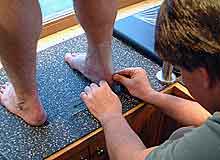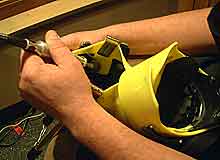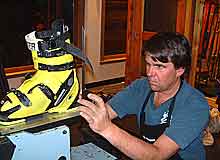
|
|||
|
|
|||

Measuring foot and leg alignment
Grinding the inside of a boot to relieve a pressure point
Measuring the sole angle during the boot planing process |
How the BOOTech alignment process works The complete BOOTech, Inc. process takes about one to two hours to complete. In most cases your new boots are ready to hit the snow at this time. The process starts with state of the art digital gait analysis. By utilizing force plate technology we are able to quantify how much pressure is distributed across the sole of the foot and across the sole of the boots. This information is of critical importance in establishing proper fore/aft balance as well as cuff adjustment, ramp angle, forward lean etc. At this time we begin to gather information about the individual. A comprehensive lower kinetic chain assessment is conducted on each BOOTech, Inc. client. This information is saved making subsequent boot purchases a more streamlined process. Particular attention is paid to such factors as tibial angle, talo-crural dorsiflexion (ankle range of motion), calcaneal angle, tracking of the knee over the foot, metatarsal inclination and pressure distribution and so on. Existing custom insoles or orthotics can be evaluated for function at this time as well. If your current footbed is working properly we are happy to work with it, if not new ones can be fabricated on the spot. The orthotic is the single most important component in the entire equation. A well made device provides a stable consistent platform upon which all the subsequent work is dependent. A poorly or improperly made device leads to excessive canting, inaccurate results and creates angles that can change with ankle flexion. The role of the orthotic is twofold. One to support and maintain the foot as close to it’s neutral position as possible. The second goal can be somewhat elusive, to allow the foot and ankle to continue to articulate. An overly rigid or excessively posted device can block the fine motor movements that occur in the foot and ankle and are critical to efficient skiing mechanics. Many technicians attempt to create the canting or final alignment within the orthotic itself. This shows a marked lack of understanding of foot and ankle kinesiology. With
a good foundation established, the measuring process is repeated. We
have determined your optimal stance outside of the boot and now begin
the process of modifying the boot to allow this structure to function
unimpeded out on the snow. The
last step and it must come last is canting. Think of canting as your
leverage over the skis. Too much leverage and the skis are hard to turn
and chatter on hard snow. Too little When you and your equipment are optimally integrated the angle of the legs is symmetrical from one to the other and is always perpendicular to that of the skis on the snow. Final alignment is achieved by planing the sole of the boot to increments as small as half a degree. To restore the boots previous dimensions to ensure proper function with the bindings in most cases a lifter plate is attached to the bottom of the boot. This method has several advantages over using urethanes or epoxies to attempt to restore the boot sole. First of all there is nothing to flake or chip off of the boot sole. Secondly you gain a replaceable toe and heel on your boots and are not walking on the portion of the sole that has been planed. Lastly, Lifters add leverage and power and create the potential for even smaller more accurate movement. This technology is commonplace on the World Cup circuit and is the same way all the racers boots are prepared. Lifters also create a very clean way to deal with leg length discrepancies. |
||
|
|
|||
|
|
|||

